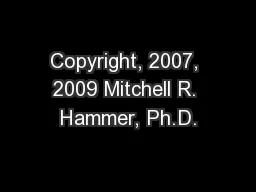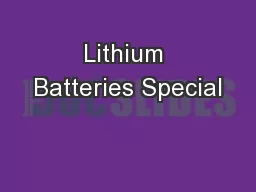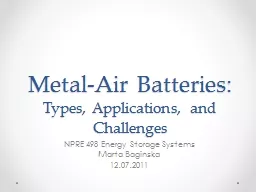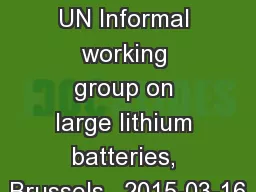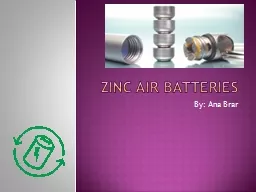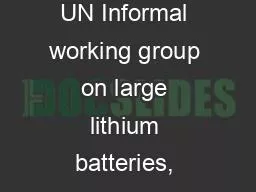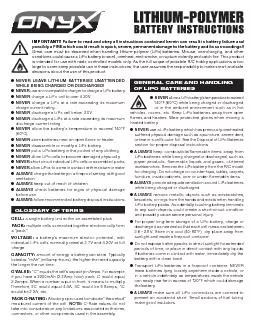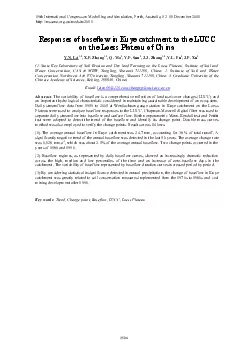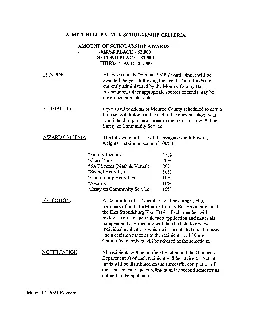PPT-Ni-Cd Batteries Alan Kim / Mitchell Stasko / Bryan Zhang
Author : pasty-toler | Published Date : 2019-11-20
NiCd Batteries Alan Kim Mitchell Stasko Bryan Zhang History 1899 Created by a Swede Waldemar Jungner 1902 Patented in the US by Edison 1946 Production began
Presentation Embed Code
Download Presentation
Download Presentation The PPT/PDF document "Ni-Cd Batteries Alan Kim / Mitchell Stas..." is the property of its rightful owner. Permission is granted to download and print the materials on this website for personal, non-commercial use only, and to display it on your personal computer provided you do not modify the materials and that you retain all copyright notices contained in the materials. By downloading content from our website, you accept the terms of this agreement.
Ni-Cd Batteries Alan Kim / Mitchell Stasko / Bryan Zhang: Transcript
NiCd Batteries Alan Kim Mitchell Stasko Bryan Zhang History 1899 Created by a Swede Waldemar Jungner 1902 Patented in the US by Edison 1946 Production began in the US 1947 Technological advances lead to creation of the. Big Garden Beak Watch. David Fuller. Big Garden Beak Watch. Carol Mitchell-Lisle. Ian Davidson. Dave Adamson. Deformity type. All species. Blue Tit. Blackbird. Starling. Great Tit. Both mandibles overgrown. 1. Evaluating Community Post-Editing - Bridging the . Gap . between Translation . Studies and . Social Informatics. Linda Mitchell. PhD student - Dublin City University . Grant agreement: 288769. Outline. Mitchell R. Hammer, Ph.D. . The Intercultural Development . Inventory® . (. IDI® Qualifying . Seminar. NIGHT ARRIVES . BETWEEN EUROPE & AFRICA. Copyright, 1998-2014, Mitchell R. Hammer, Ph.D., IDI, LLC, used with permission. Provision 188 of IMDG Code 38-16. Prepared by Shashi . Kallada. www.shashikallada.com. LITHIUM BATTERIES. Lithium Ion Batteries are rechargeable batteries. Lithium Metal Batteries are single use batteries (Primary Batteries) . NPRE 498 Energy Storage Systems. Marta Baginska. 12.07.2011. Outline. Introduction. Scope of the presentation: Where do metal-air batteries fit in?. General characteristics of metal-air batteries. Factors the affect performance. 1. Proposal for a harmonized . Battery Definition. Dr. Thomas Dittrich. Team leader JMT 18. Transport safety of lithium cells and batteries. IEC TC35/SC21A . Outline - . Harmonized Battery Definition. Dr. John Warner. December 15, . 2017. Introduction. Electricity is inherently mysterious. We do not have a sense to detect its presence. Sight – detects light. Hearing – detects sound. Smell – detects chemical vapors. ©2018 Energizer. Energizer and the Energizer Bunny design are trademarks of Energizer Brands, LLC. All other brand names are trademarks of their respective owners. Use of them does not imply any affiliation with or endorsement by Energizer Brands, LLC.. General Information. Activated when oxygen is absorbed into the electrolyte through a membrane. Usually reaches full operating voltage within 5 seconds of being exposed to air. Oxygen diffused directly into battery. 1. How Can the Confusion About the Battery Definition be Overcome?. Dr. Thomas Dittrich. Team leader JMT 18. Transport safety of lithium cells and batteries. IEC TC35/SC21A . Outline - Battery Definition. GLOSSARY OF TERMS CELL: a single battery unit within an assembled pack.PACK: multiple cells connected together electronically form a 1 State Key Laboratory of Soil Erosion and Dry land Farming on the Loess Plateau Institute of Soil and Water Conservation CAS MWR Yangling Shaanxi 712100 China 2 Institute of Soil and Water Conservat A MITCHELL PALMER SCHOLARSHIP All fully completed Applications must be returned to the Guidance Department who will complete the last page aid forWatirallcto Mark A PrififrOle ticiiire17 North SiithSt Hospital of the University of Pennsylvania. The Importance of Coughing . Patient History. 76 year old female was admitted to the pulmonary unit in the hospital due to shortness of breath, recurrent cough, fatigue and weight loss..
Download Document
Here is the link to download the presentation.
"Ni-Cd Batteries Alan Kim / Mitchell Stasko / Bryan Zhang"The content belongs to its owner. You may download and print it for personal use, without modification, and keep all copyright notices. By downloading, you agree to these terms.
Related Documents



